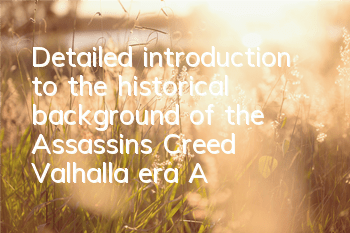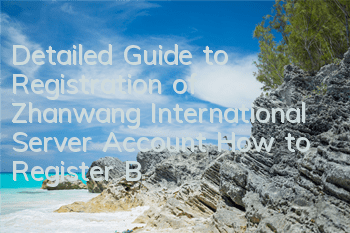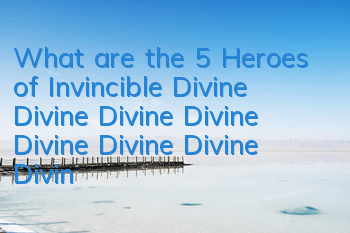As the ending of the "Mythical Trilogy" series "Assassin's Creed" series, "Assassin's Creed: Valhalla" brings players back to Europe in the 9th century AD, and witnesses how the British islands of the "Dark Ages" meet the challenges of the fighting nation from the cold north from the cold north with the perspective of the Viking warrior "Aivor". At the same time, players must also take their tribe members to settle down in the British islands, seek development, and seek opportunities in strange lands.
Compared with the ancient Egypt and ancient Greece involved in the first two works, the history involved in "Assassin's Creed: Valhalla" does not have an advantage in popularity. Most of people's impressions of Vikings remain on "pirates", "bescarers", and "good at navigation", but they do not have a clear and systematic understanding of the situation in Europe in their contemporary era. This article will give a brief overview of the aspects of the Vikings and Europe in the 8th and 11th century through the form of questions and answers, trying to initially restore the situation in Europe in the "Dark Ages" and the rise and fall of the Vikings who have multiple identities at the same time.
Who is the Vikings? Where did they come from and where did they go?
The Vikings are not citizens of a specific ancient country. This title is a general term for immigrants from Nordic regions such as ancient Norway, ancient Denmark, and ancient Sweden. In ancient Norwegian, they were called "víkingar", which means "sea adventure"; while in ancient English, they called "vikinger" means "people in the bay" - such titles reveal the fact that the Vikings were a group closely linked to the ocean, and they came to Europe through cross-sea sailing and had a profound impact on Europe at that time.
In fact, "Vikings" are not the only name of this group. The Nordic people including Ever are called "Norsemen/Northmen" in the game, which is a typical English expression, meaning "Northern people" is an incisive answer to where they originated; and "Dan people" is a slightly biased and one-sided title. This title was originally the name of the Anglo-Saxon people for the first invading Britain. The Anglo-Saxon people could not distinguish the difference between the Danes and later residents of Norway, Sweden and other places. Therefore, later, "Dan people" or "Dan people" was used as the general term for the Vikings. If you observe the dialogue in the game carefully, you will find that the Anglo-Saxon people in the game are mostly called "Dan people", while the Vikings such as the Black Crow clan are called "North Warriors".
North
Strictly speaking, the Vikings—or the North, were a branch of the Germanic peoples (the other two were the Celtics and the Slavs) in Central Europe, located north of the Elbe River in Central Europe. In the 4th century, a large number of Germans were affected by the chain reaction of the westward advance of the Huns (the tribes to which Attila, the "Whip of God" generally believed that there was no direct connection with the "Huns" mentioned in ancient my country). They migrated south from their birthplace, northern Europe (including the Scandinavian Peninsula), and clashed and merged with the Roman Empire at that time, and eventually became the main driving force for subverting the Roman Empire. However, unlike many Germanic compatriots, the North did not leave the Nordic region, but settled in the local area in the form of blood clans and tribes, living a primitive society life with slow development but uncontested.
This status quo was broken in the late 8th or 9th century. Historians have different opinions on why the North had left their settlement in Nordic countries, but there is no final conclusion at present; it is generally believed that it was caused by the development pressure brought by population growth, or the many social contradictions and class differentiation that occurred at the end of the development stage of primitive society (the latter type is reflected in the game) - In any case, these Nordic Germans left the land where they settled in the times, formed a gang to go to sea on a boat, and carried out a plunder like a wolf or a tiger,For the fearsome "Viking Pirates" at sea.
For the Norths, it was a journey of pursuing wealth and the glory of warriors, and this journey did not have an end; despite this, by observing its origin and its invasion, it could still be divided into three branches: the Denmark Nos, the Norwegian Nos and the Swedish Nos. The Norths from Denmark mainly attacked France and the English region of today's Britain; a group of Norway, who were born in Norway, pointed their finger at Scotland and Ireland; the Swedish Norths headed towards the eastern part of the mainland, entered the land of the Slavs, and became the "Varangian" or "Ross" (Рѹ́сь/Русь) of the Slavs. For more than three centuries, the Vikings influenced Britain and even Europe in various ways. It was not until William I defeated Harold Godwinson (harold II, 1022-1066) with a Norwegian background and ruled the entire territory of England in the Battle of Hastings, which marked the decline of the Viking's wave of external expansion.
·What are the characteristics of the Vikings' robbery?
In the 9th and 10th centuries, Europe was invaded by three foreign forces almost at the same time. The North Americans from Northern Europe were only one of them (the other two were the Hungarians from Middle East Asia and the Moors from North Africa); compared with the other two forces, the North Americans, as branches of the Germans, had some unique characteristics in their military operations, mainly focusing on equipment, combat methods, and targets of attack..
First of all, the most obvious feature of the North people is launch attacks by boat - their nickname in Iceland, Britain and other places also showed this directly. The ships that the North were riding on were called "Langskib". They first appeared in the late 8th century and developed rapidly from the 9th to the 11th century due to war needs. By the 13th century, they were basically established and regarded as the peak of shipbuilding technology in the Scandinavian Peninsula. Their manufacturing, morphology and other characteristics can also be found in the contemporary Scandinavian shipbuilding industry. Because this kind of oak ship is mostly carved with complex dragon-shaped decorations at the beginning and end, it is also called "Dragonboat" - in the game Ever also called the long ship "Dragonboat", but be careful not to be regarded as the same thing as the Dragon Boat boat in China;
Longboat
The biggest feature of a long boat is that it has no deck. The sharp bottom reduces the draft of the ship and is conducive to the ship's rapid navigation in waters with gentle currents. In addition, the use of square sails allows the North to drive quickly in the waters, achieving pursuit or avoiding the enemy's pursuit. Depending on the number of people a vessel can carry, long ships can be divided into many different types, most of which are deckless. Although the deckless design abandons more carrying space, it can also be regarded as a compromise to lightweight and specialized transport personnel, an adaptation to the needs of war. Among them, the smallest war-time long ship Snekkje (the name means "slim and narrow", but it is not the smallest long ship. There is also a smaller non-war-time long ship Karvi) that can carry 40 oarsmen, while the largest Busse is 50 meters long and can accommodate 70-80 people. At the same time, cargo warehouses that other long ships do not have are reserved, which are enough for trans-ocean voyages and long-term operations (there is a saying that the word "Bus" in English comes from such large long ships);
Modern restoration of Viking longboat
Secondly, the Norths used a unique weapon - the Tomahawk (Axe). The North’s tomahawks were originally derived from the hand axe for logging, and gradually evolved into two styles of short and long shanks during the long war. The short-handled battle axe handle is generally about 40 cm, which is more convenient to use than the common long and short swords at that time. It can be held with one hand, and combined with a circular shield, it can be both offensive and defensive, and it can also be thrown out on the battlefield to attack farther enemies. The long-handled battle axe handle is mostly more than 1 meter, and some are even as long as 1.8 meters to 2 meters. It requires holding it with both hands, and generally launching a charge.It is used to control the field or cause a large-scale deterrence. No matter which kind of battle axe, the axe blade part is strengthened, which is wider than the logging axe, which is conducive to destroying the enemy's defense on the battlefield - this can also explain how the various cruel ends in the game come from;
A Viking axe with Mammen style patterns
Third, the North’s looting was religiously destructive. The Hungarians of the contemporaries used the high maneuver power of the cavalry, and most of them chose to avoid cities with large populations and strong defenses, and specifically plundered the countryside (this is also related to the shortcomings of the cavalry themselves in position attack); while the Norths chose monasteries to start. Since the "Pipin Dedication of Land" in 756, the power of the Christian Church in Western Europe has increased significantly. By the 9th century, many monasteries with strong wealth foundations had emerged across Europe. These monasteries soon became the targets of the unbeliever Norths. The war started from the monasteries and soon spread across Europe. In the subsequent invasion, the Norths, as pagans, attached particular importance to the plunder of church faith spread centers such as cities and monasteries. Although it was largely because these places accumulated more wealth, it cannot be said that the Norths attacked them for religious considerations; but objectively speaking, the attack on such areas expanded the degree of destruction of Christian faith, and could also be regarded as a military action with religious purpose.
·What famous Viking pirates appeared in the war at that time?
There were many famous Viking pirates in the 8th and 11th century. The reason why they were described as "pirates" was because the purpose of these North Koreans voyages was often to seek more living space and means of production, and the means of achieving this goal was often to start wars and looting; specifically, this period can be divided into two stages: the 8th and 9th centuries and the 10th and 11th centuries. Many famous Vikings in the previous stage were often famous for their military achievements, while some Vikings in the latter stage focused on the attribute of "exploration".
The Vikings who launched military operations against Europe in the 8th to 9th centuriesong>As an example. The most active Vikings during this period and feared the people of all parts of Europe were the semi-legacy and semi-real Ragnarr Loebrók (?/810-?/865) and his sons. It is said that Ragna was a Viking leader in Denmark, Sweden and other places, but his own story has many doubts, and most of his deeds were incomplete and unknown (such as the "Lagna's Long Poem" in the 9th century, with only a few remaining chapters recorded in "Prose Edda" in the 13th century). Most of the records about his life appear after his death. It is said that in 845, he once led his army to besiege Paris, the capital of the French Kingdom, forcing the French king Charles le Chauve (823-877) to pay a large donation, making Ragna's name famous throughout the Viking world; according to the Ragnars saga loðbrókar and Ragnarssona þáttr / þáttr af Ragnarssonum, Ragnarssona þáttr / þáttr af Ragnarssonum, Ragna finally drifted to the Kingdom of Northumbria in northern England due to a shipwreck, and was thrown into a pit full of poisonous snakes by King Ella, and died of the bite of poisonous snakes;
Ragner Lord Brock
Of course, due to the diverse sources and the lack of reliable historical records, Ragna himself had a slightly superior legendary nature; but his most famous son, Ivar the boneless (about 794-873), and Björn Ironside (?-about 876), nicknamed "The Brave", are more real. According to different documents such as "Biographies of Ragna", there are different numbers of Ragna's sons, but almost every document mentions his eldest son Ivar and his youngest son Bjorn (there are also the saying that Bjorn is the eldest son and Ivar is the last brother). The former was the commander who led the Vikings to invade England and Ireland, while the latter was the king of a country that established the Munsö dynasty (a dynasty in the original Swedish history) in Sweden for centuries. Interestingly, Ivar's nickname "The Boneless" was speculated by historians to be related to his congenital skeletal disease (brittle bone disease or chondrosis), which was related to his brother.Another translation of Brother Bjorn's nickname "Ironside", "Ironside", forms a sharp contrast.
In the game, the player played Everill will meet the notorious "Boneless Man", who will be with his brother Ubba Ragnarrsson. The name of this person is in "Annals of St. Neots", and is mentioned as the leader of the Viking Army in this English document; in fact, the historically led the army to invade England with Ivar was Halfdan, who was nicknamed "White Shirt", a nicknamed "White Shirt", a man named Halfdan, who was nicknamed "White Shirt". Whiteshirt, while other legends mention that all of Ragner's sons were involved in the revenge of England) went to war with East Anglia and Mesia under the Anzha people; Evor will fight alongside these fierce brothers, and see with his own eyes the origin of the title "The Boneless", which is slightly different from the official history, and the end of the life of Ivaljung.
Ivar in the game
·What was the situation in Britain in the 8th and 10th centuries?
First of all, unlike the "United Kingdom of Great Britain and Northern Ireland" in the current public perception, there was no unified country on that land at that time, so naturally there was no concept of "UK". Since the 5th century AD, the Anglo-Saxons fought in Britain and successively established seven regimes, namely Kent, Sussex, also known as the South Saxon, Wessex, also known as the West Saxon, Essex, also known as the East Saxon, Northumbria, East Anglia, and Mercia. These seven regimes essentially belonged to the loose clan tribal period.ng>Informal Alliance, but because of the existence of a king and a simple monarchy and ministerial bureaucracy, it is also called a "state". From the end of the 5th century to the unification of Wessex in 829 AD, this period of nearly 400 years was called the "Heptarchy" (Heptarchy); on the map in the game, players will be able to intuitively see the distribution range of power in these countries;
Schematic diagram of the "Seven Kingdoms Era". At that time, Britain was divided up by the Celtics who came here earlier, and the sphere of influence of the Anza people was mainly concentrated in the western region
At the same time appear on the map, there is an administrative division called "shire" (old English sćir). The division "county" first appeared in the Kingdom of Wessex in the south of today's England, and later spread to other parts of Britain around the 10th century; its essence was that the king established it to strengthen its rule over the land that directly belonged to him. Usually, a county contains more than a dozen to more than a hundred residential areas, and unified the sheriff (also known as "county governor") assigned by the king to rule; players need to win more allies for the Black Crow clan of Aivol in England, and some county governors are one of the important targets of alliance.
Above mentioned that the North Americans from Northern Europe invaded England in the 8th to 10th centuries. The first to invade Britain and establish settlements, colonies and even kingdoms in the local area are the Danish Nos, who are narrowly called the "Dans". At the end of the 8th century, the Danes had already begun to invade the eastern coast of England. It is recorded that many monasteries in Northumbria were looted and destroyed; in the mid-9th century, the Danes even went south to attack London and established a stable winter settlement area in Britain. They no longer returned to Denmark in winter, and gradually formed a sphere of influence exclusively to the Danes in the northeast of England. This was an intolerable force compression for the Ansas people who formed an inherent sphere of influence in Britain, so the Ansas people's resistance did not stop for a moment; but before the military operations led by King Alfred the Great King (849-899) of Wessex in 870, the Ansas people in England did not achieve much victory;
After in 878, Alfred won a huge victory in the war in Edington, forcing the Danes to agree to permanent peace and sign a treaty. The two sides agreed to divide the large tracts of land in northern and eastern England about 25,000 square miles to the Danes as residence ("Danish Far District"), thus establishing the situation of coexistence between the North and the Anza people. In the plot, players will have the opportunity to participate in this historical event and meet the King Alfred himself, who was later revered as the "Emperor" by later generations. Although Alfred in the game seems more sinister, elegant and good at power-making than the historical military and civilized ones; the object of his contract was not only the simple Danish army, but the "Dan people" in a broad sense, including the Black Crow clan.
King Alfred in the game
·What representative leaders were there in England at that time?
If we look at the situation where England was divided at that time, it is really hard to say which country led by the monarch had absolute advantages - the Kingdom of Wessex, located in southern England, may have been more geographical bonus, unlike Kent and Northumbria in the north, which became the landing point and primary target of the Vikings; but even so, there were still some very influential monarchs at that time, the most representative of them. Nothing is Alfred, the king of the Anglo-Saxons.
Alfred
There is a saying: If a foreigner goes to England and does not know the "Lion Heart King" Richard I and the Crusades, it is not important; but if this person does not know the Alfred the Great, he may be said by the British that he has never been to England. The "Alfred the Great" mentioned in this statement refers to Alfred, the ruler of the Kingdom of Wessex. The previous entry mentioned that Alfred and the Kingdom of Wessex he ruled were the mainstay of England's resistance to the Viking invasion, and it was also one of the few forces among the seven England countries that stood firm under the Viking offensive (by 869, Kent, Northumbria, Mercia and East Anglia had all become things in the hands of the Vikings) - on the one hand, it was closely related to Alfred's own talents, and on the other hand, it had to be said that he was lucky: Guthrum, who was not as prestige as Ragner's son, was the son of Ragner. Alfred adopted a tactic to clear the fields to reduce the food and grass supplies that the Vikings could plunder, and adopted a consumption method in combat, which were all important factors for the victory of the Wessex army.
"If you want peace, you must prepare for war first", and you will win by chanceAlfred of Leigh realized that a victory would not have a decisive effect, so he immediately set out to reform the army. Alfred first strengthened and maintained all cities, strategic areas and channels in the territory based on the ruins of the fortifications built by the Romans in England, and initially established a defense network system that could effectively resist the attack of the Vikings. Later, he changed and improved the old land tax system, emphasizing that in addition to paying taxes, land holders must also serve in the kingdom. Every adult male must join the army, build and guard fortifications, forming a military town system of "plowing in peacetime and wartime alert"; finally, the most important and far-reaching one was the naval construction that Alfred ordered in 882 (so many British people used to regard 882 as the birth time of the British Royal Navy). In view of the number and speed of the Viking long ship, Wessex has built a larger and more comprehensive long-distance ship, and has initially formed a maritime military force that can compete with the Vikings;
In addition to his eye-catching martial arts, Alfred also has made outstanding achievements in civilized governance - Alfred has always been troubled by illness in history, but this does not prevent him from having courage and wisdom that are difficult to reach for by ordinary people. He loves academics and advocates increasing the literacy rate in both the religion and secular worlds of Wessex, and strives to translate the vast Latin works of the Roman era into Ansai language. In addition to summoning a large number of scholars to write and translate works, Alfred himself also participated in the compilation of various documents. It is said that the famous "Anglo-Saxon Chronicles" was compiled by Alfred himself. Various measures to enrich the country and strengthen the army were compiled by Alfred himself. It made Wessex develop comprehensively in military, diplomatic, science, literature, and religion, and gradually develop into the most powerful kingdom of England, laying a solid foundation for the later unification of the whole of England. Alfred was also respected by future generations as the "Father of the British Nation" for his unprecedented and unfamiliar achievements, and became the only "Father of the Great" in British history. King's King (the reason for emphasizing the "Onza" is that there was a British monarch who ruled Wales in the same time, Herodri Apmephin, who also enjoyed the title of "The Great Emperor", and the British belonged to the Celtics; this monarch will also appear in the game), and is regarded as the most representative historical figure in Britain.
Statue of Emperor Alfred
·Why do Roman-shaped characters appear in the game? Rome, EnglandWhere have people gone?
From around 100 BC, the Romans had already had trade contacts with the residents of British land; later they dispatched large troops to conquer England, turning it into the Roman province of Britannia for more than four centuries. In other words, British history has been ruled by the Romans for nearly 1/5, so it is not surprising that some Roman-like characters appeared in England in the 8th century; but these people just looked like Romans and were not real Roman residents - because the Romans on this land of England all evacuated as early as 408 AD.
Everything starts with the great Geus Julius Caesar. In 58 BC, Caesar launched a war against the Gaul region (now France and Belgium). In 8 years, Caesar launched eight expeditions against Gaul and finally incorporated Gaul into the territory of the Roman Republic. During the war, Caesar and the Romans established several military bases along the coast of the conquered areas, which were only separated from the English Channel across the country, so the Roman Republic quickly turned its sight to England. In 55 BC and 54 BC, Caesar launched two expeditions against Britain, but returned in vain. Originally, Caesar wanted to continue to conquer the stubborn Celtic tribes, but the breakdown of the "First Three-Head Alliance" later forced him to shift his focus to open and secret struggles with Pompei and the Senate - which brought Britain to peace for nearly a century.
After Caesar's death, his successor Augusto Octavian established the Roman Empire. At the beginning of the empire, Augustus and his several successors had more or less the idea of conquering Britain, but none of these plans were implemented for a variety of reasons. Until the fourth emperor of the empire, Tiberius Claudius Drusus Nero Germanicus (10-54 BC), ascended the throne, the chaos within Britain provided an excuse for the Romans' attack. In addition, Claudius I also urgently needed victory in a large war to consolidate his throne. Therefore, in 43 AD, Claudius I sent an army of about 40,000 people to Britain, and in less than half a year he conquered the Celtics and classified Britain as a Roman province called "Britania".
Claudi I
But the Roman rule in England was not solid. On the one hand, the Celtic tribes ruled by the Romans were not convinced. The rebellious smoke often ignited from Britannia. The largest of them was the uprising launched by the British tribes in southeast England in 61 AD, Boudica (?-61), the queen of the Icene. Although the uprising was quickly suppressed, the Romans, who were still scared, reduced their oppression on the Celtics and appropriately gave certain power to the tribes of Britain;
Budica. She was later regarded as the guardian goddess of Sagittarius by European fortune tellers
On the other hand, the stubborn resistance of the Scots and the Celtic tribes in the north made the Roman Empire's military operations in Scotland and northern England more difficult. In order to consolidate the current situation and resist the attack of the Scots, the Roman Emperor Publius Aelius Traianus Hadrianus (76-138) personally went to Britain in 122 and ordered the construction of a 117-kilometer-long fortification that runs through the east and west of the island, namely the "Hadrian's Wall" which took six years to build; based on the Great Wall of Hadrian, the Romans gradually advanced the sphere of influence to the north. Twenty years later, the successor of Emperor Hadrian, Antoninus (Antoninus), the heir of Emperor Hadrian, was named Antoninus. Pius, 86-161) also built a 63-kilometer defensive wall in the north of Hadrian's Great Wall, for the "Antonine Wall" - but because of the outbreak of the emergency war, the legion that built the Antonine Wall was transferred, resulting in the Antonine Wall becoming an unfinished project, making the actual northern border of Britannia still the Hadrian Great Wall built during the reign of Emperor Hadrian; relying on the Great Wall, the Romans were able to gain a foothold in Britain and maintain a relatively stable situation.
Schematic diagram of Hadrian's Great Wall and Anthony's Great Wall
The ruins of Hadrian's Great Wall. Although it is also called the "Great Wall", the Roman Great Wall is far less refined than the Ming Great Wall of China - but it is probably still more perfect than the Qin Great Wall
With the protection of the Great Wall, the Roman Empire began to manage its internal affairs with peace of mind, and the Romanization level of Britannia became increasingly greater and gradually flourished. Lon, who will be called "London", will be called "London" in the future.dinium and York in the north are the centers of the north and south. Cities are gradually appearing on the land of Britannia, with more and more council halls, public bathhouses and squares full of Roman characteristics, which is no different from the empire's locality; the religious tolerance policy of the imperial authorities allowed the Celtic primitive religion and later Christianity to coexist in a relatively peaceful manner, and the tendency of faith integration appeared.
This prosperity continued until the end of the 2nd century AD. Starting from the end of the 2nd century, the Roman Empire fell into a century of chaos, known in history as the "3rd Century Crisis". The "3rd Century Crisis" brought about problems such as the decline of agriculture, the depression of business, the decline of a large number of urban and rural settlements, political chaos, and constant uprisings. The invasion of a large number of barbarians around the empire was even worse. The double weakness of politics and military made the Romans increasingly lack control over remote areas. The border defense slack brought about by social unrest gave the surrounding barbarians an opportunity. The Germans in the north went south in large numbers, breaking through the border line and entering the empire, bringing huge pressure to the empire.
At this time, Britania, far overseas, was on the verge of being out of control. In order to concentrate the army and maintain the rule of the empire, in 408, all the Roman legions stationed in Britannia evacuated, marking the complete abandonment of the sovereignty of the British islands by the Roman Empire. In this way, the Romans disappeared from the land of England, leaving only the various Romanesque buildings and cultural remnants they built. Some of these social and cultural heritages were destroyed by the Anglo-Saxons and Jutes who later entered England, becoming broken walls and winding silently; a few infrastructure built on strategic impetus may have the possibility of being re-activated (a defense network built by Emperor Alfred the Great), but that has nothing to do with the Romans and the Roman Empire - the story of the "Seven Kingdoms Age".
However, the Roman Empire left some traces of the four-century rule over England. In the game, when players control Evor, they can see some ruins with Roman architectural style. If they look for it a little, they may find some old objects with the mark of the old empire; if they bring these old objects back to the residence of the Black Crow clan, they may find people who are interested in them.
Are the Vikings really just pirates and invaders?
In people's stereotypes, most of the Vikings are fighting nations that are keen on aggression and plunder; rather, the traditional Germanic nations give people this feeling. But any nation is not just a flat stereotyped image. The complexity and diversity of groups determines that "nation" must be a concept with complex connotations - the Vikings are such a typical case. In sharp contrast to the wild side of the Vikings who were desperate and longing for entering Valhalla is the clan meeting of the Vikings, which has the prototype of parliament and a unique literary and artistic form; what must be said is their "traveler" qualities, which is exactly what Assassin's Creed: Valhalla" wants to display.
Compared with the other two forces invading Christian Western Europe in the 8th to 10th century - the Hungarians and the Moors, the Vikings had the characteristics of forming immigration activities in the conquered areas. After the Vikings conquered a region, they often spent the winter, settled, and even established states and regimes. Take the Danish Nos as an example: at the end of the 8th century, the Danes began to attack England, and took root in the local area for more than a century, forming their own circle of influence; at the beginning of the 11th century, the King of Denmark Knud II den Store/ Cnut the great, 995-1035) also held several titles of King of England, King of Norway, and King of Denmark, ruled the entire Scandinavia and England, and established the Knut Empire across the Northern Europe;
Knut
On the other hand, the Vikings' journey at sea was not limited to Western Europe - this part is mainly related to the Norwegians. In the mid-9th century, the Norwegians and the Danish Norse pointed their finger at Ireland and seized large tracts of land. Afterwards, they continued to sail westward, to the higher latitude Iceland, and immigrated a large number of people to this uninhabited barren land, developing a unique Nordic culture; after Iceland was familiar with the situation, the Viking navigators continued to explore westward. In 983, Erik Thorvaldsson/Erik the Red (950-1003, also known as "Red-Haired Eric", "Red-Bearded Eric") set sail west from Iceland.After sailing, I found that there was a huge frozen island west of Iceland. His ships were circling the frozen soil from east to west until they found an ice-free land. After living in the local area for 3 years, Eric returned to Iceland on the same road, looking for people who were willing to move to the new land with him. In order to attract new people to the new colony, he called the frozen soil "greenland", that is, "Greenland" - now Greenland;
"Red-haired" Eric
In 986, Eric left Iceland with a fleet of 25 ships. After a series of accidents such as shipwrecks, the remaining 14 ships arrived in Greenland, and established a Scandinavian resident community of varying sizes in the local area. Originally, the Vikings had ambition to continue to expand on the new land, but the failure of the war with the local indigenous people (Inuits) forced them to dispel the idea and instead make a living by fishing, hunting, logging and trading with local residents; afterwards, Eric's son Leifr Eiríksson/Leiv Eiriksson, about 970-1020), followed his father's deeds and continued to sail to the south of Greenland. Lef first arrived at an island full of flat stones, named it "Helluland" (Helluland), and then headed south to a relatively flat island with large woods and beaches, and named it "Markland" (Markland) - these two places are now located in Baffin Island in Canada and the Labrador Peninsula in Hudson Bay;
Immediately afterwards, Lef continued his sailing south and discovered an island rich in resources. The rivers here are full of salmon, and grapes grow on the land; the climate is warm and pleasant, much warmer than the ice and snowy Greenland, and even the grass on the ground is green in winter. Lef then spent the winter on this island and gave the island a name, "Vinland", which means "Grassland" or "Grassland" - where is this place called "Vinland", modern researchers have always had different opinions. It is generally believed that it may be located in the L'Anse aux Meadows site in the north of the Newfoundland Peninsula in Canada. Later archaeological research proved that this place was justa ship rest point), or in Newfoundland Island, the Gulf of St. Lawrence, the Gulf of St. Lawrence.
Lef Eriksson. On the way back to discover Wenlan, Leif saves a Norwegian who died at sea, so he gets the nickname "Leif the Lucky"
Schematic diagram of the Vikings' long-distance route
From the perspective of exploration, the Vikings represented by Eric, Lef and others were the navigators who discovered America earlier than Christopher Columbus. Lef was officially recognized by the US government as the discoverer of North America (announced by Lyndon Baines Johnson, the 36th President of the United States in 1964); their achievements do prove the fact that the Vikings are not just plunderers, but more complex navigators and explorers. In this Assassin's Creed: Valhalla, Aivor will travel across the ocean and come to the land of Wenlan to complete a secret goal; here, he will meet some strange residents - but if he is an old player in the Assassin's Creed" series, he should not be unfamiliar with these indigenous people, but will feel a little familiar and surprised.
·Where did the descendants of the Vikings go?
Although the Vikings were invincible and invincible in Europe during the "Dark Ages", their "sea nation" characteristics determine that it is difficult for them to take root permanently in a piece of land, or be expelled by local forces, or take the initiative to leave to find the destination for the next journey, which determines that it is difficult for them to form a stable and developing civilization in a certain area. After the 11th century Viking expansion wave gradually subsided, the power they had operated outside Nordic Europe was gradually weakened and divided. The Vikings who settled in these places either returned to the cold Nordic Europe or were assimilated and integrated by other local ethnic groups, and almost never formed a separate foreign group (of course, there are exceptions) - Here we take the three North Korean branches mentioned in the article as an example, and talk about the fate of the Vikings after the 11th century.
The descendants of the Denmark Nos did not have many deeds worth mentioning. After the land division with King Alfred in Wessex in the late 9th century, the Danish Nos people gradually stabilized in the "Denmark Ferris" in northeastern England. Although the Danish king Knut, who occupied England, established the vast Knut Empire in the early 11th century, this unstable regime fell apart after Knut's death, and the Anza people regained control of England. After that, the Danes in England had no more big news. They were content to be ruled by the king of the Ansas, gradually assimilated with the local residents, and became part of the Anglo-Saxons. Anyway, both of them themselves belonged to the branches of the Germanic people, and this ending was considered a different end;Norwegians later developed much more generously. Since England was mainly occupied by its fellow Denmarks, the Norwegians mainly targeted Scotland and Ireland, and accelerated their invasion of the Frank Kingdom after the mid-9th century. At that time, a Norwegian pirate leader named Rollo (860-930), appeared. It is said that he was the brother of Harald Fairhair (850-932, who also appeared in "Assassin's Creed: Valhalla") who ran away because he was unwilling to compete with his brother for the throne. Later, a large number of pirate troops were formed to scatter all over the mouth of the Frank River, and even went up the Seine River to siege Paris. In 911, King Charles III of France (Charles the Simple, 879-929) made a contract with Rollo (Treaty of Saint-Clair-sur-Epte), promising to grant the latter the land on the coast of the Seine Estuary to the latter and grant the latter the duke. Since this land was assigned to the rule of the Norsemen, there is another name here - "Normandy", and Rollo also made itThis became the first Duke of Normandy.
Rollo
Later, more and more Northes came to Normandy to settle down. By the 11th century, Normandy had become the great feudal corps of France. The Northes (specifically referring to the Normans and their descendants) also had the titles of "Normans" and "Normans". In 1066, William I, the then Duke of Normandy (about 1028-1087), launched the conquest of Britain ("William Conquest"), successfully conquered Britain and established the Normandy Dynasty (House of Normandy, 1066-1154) - this Duke of Normandy, named William, was William I, nicknamed "Conqueror". Unlike the original Germanized Anzha and Scandinavians, although the Normans are also descendants of the Germans, their political and cultural systems are both French; although their rule over Britain was not long, it gradually connected Britain, which was separated from the European continent, forming a situation where the Anglo-Saxon culture and French culture were integrated, which was conducive to the long-term development of Britain; although the Normans' Norman dynasty was replaced by the French-borne Gorebaceous dynasty in the mid-12th century, their genes more or less left a mark on the British bloodline, so in some sense, Norwegians can also be regarded as one of the distant ancestors of contemporary British people;
"Conqueror" William I
As for the Swedish North Koreans, the path they took was more erratic. The Swedish Norths did not choose to fight to the death in Western Europe, but went east and went deep into the Eastern European Plain. These North Americans from the other side of the ocean occasionally do small business with Eastern Europeans, but more often they rob their families on the business roads of the Eastern European plains, plundering caravans and captive populations, and then sell the stolen people and goods to Constantinople on the Mediterranean coast; residents on the Eastern European plains, mainly the Eastern Slavs called these outsiders who were both thieves and trades "
According to the first complete chronological history of Russia, "Chronicles of Previous Years", the Ross migrated south from the Baltic coast and was later expelled from the East Slavs to the sea; but the East Slavs immediately fell into endless struggle and finally discussed in 862 to invite the Nordic people back to rule them. So the Ross, led by Liurik (Рюрик Великий князь, ?-879), returned to the Eastern European plains, established the regime with Kiev as the base, and then established the Ryurik dynasty that ruled Russia for more than 700 years (Ryurik dynasty/ династия Рюриковичей, 862-1598)——The statement of "Please come back" seems a bit too subtle. Some historians believe that this is the beautification and embellishment of Liurik's rebellion against the enemy and seize power by force; but it is undeniable that the Swedish Ross people took root in Eastern Europe, and later gradually merged with the Eastern Slavs, the Chincha and other ethnic groups, becoming one of the direct ancestors of the modern Russian nation;
As for those Vikings who sailed to America, they did not last long in the unfamiliar vast land. The number of Norths arrived in America was very small. Even at the heyday of the development of the local Viking community, it was only about 5,000 people, and it was far from competing with the indigenous people with a large number of local people. The high latitude, strange environment and confrontation with indigenous peoples continued to weaken the Vikings' will to survive, and finally made the Norths migrating to America completely silent in the 15th century more than 500 years later, and there was no room for integration with the local residents. The only way to wait for them was migration.
The site of Hvalsey Church on Greenland. This is one of the many traces of survival left by the Vikings in the Greenland region
Now, there are almost no Viking production and living sites in the Americas outside Greenland, which also proves thatIt is clear that the Vikings' exploration in the Americas ended in failure; however, the Vikings' five-century pioneering in the Americas just confirmed the qualities of the travelers and warriors engraved in their bones and blood. "The unyielding man who sang the war songs sailed towards the glorious Vikings. His horse rose up with flames and rode the wind and waves all the way away" - this will not be erased even in a foreign land.









